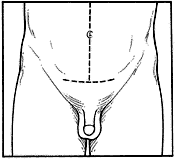
|
A selection from:
Mayo Clinic on Prostate Health
Continuing from Chapter 7 (go to previous part)
What Are Your Options?
Removing your prostate gland
The surest way to cure cancer that's confined to your prostate
gland is to remove the gland. This type of surgery is called radical
prostatectomy.
Until a few years ago, a radical prostatectomy just about
guaranteed devastating consequences: Nearly every man who
had this procedure became impotent or suffered from diminished
sexual function. Many men had bladder problems. In addition,
most men had so much blood loss during the surgery that they
needed transfusions.
New procedures and instruments developed during the
past two decades have changed this surgery drastically. Surgeons
now use special techniques to cut free the prostate, while
sparing muscles and attached nerve bundles that control urination
and sexual function. Methods to control heavy bleeding are
now routine.
Because of these refinements, 1 in 4 men with prostate cancer
now choose surgery. A decade ago, only 1 in 10 chose surgery.

|

|
|
With retropubic surgery [left], the prostate gland is removed through an incision in the lower abdomen. Perineal surgery [right] involves removing the gland through an incision between the anus and the scrotal area.
|
Retropubic surgery
Retropubic surgery is one of two methods for removing the
prostate. In this procedure, the gland is taken out through an
incision in the lower abdomen that typically runs from just below
the navel to an inch above the penis (see illustration).
It's the most common form of prostate removal for two reasons:
The surgeon can use the same incision to remove surrounding
lymph nodes/ which are tested to make sure the cancer hasn't
spread. In addition, the procedure gives the surgeon better access
to the prostate, making it easier to save the nerve bundles that
control erection.
The night before surgery you'll likely be given an enema or
laxatives to clear your rectum of any fecal matter. This reduces the
chance of infection if the rectal wall is punctured during surgery,
an uncommon but possible risk.
You may choose to be put to sleep during the surgery with
general anesthesia, or have an epidural injection that numbs only
the lower half of your body. General anesthesia is more common.
After the incision, the surgeon may remove lymph nodes near
your prostate and send the sample to a pathologist. Enlarged or
suspect lymph nodes can be evaluated by frozen-section techniques
to determine if cancer is present. Results are often known within
15 to 30 minutes. If cancer is found, your surgeon may close the
incision without removing the gland, or may proceed with the
surgery. The decision to proceed in light of positive lymph nodes
depends on the number of lymph nodes involved, your age, and
associated symptoms. The fewer nodes that contain cancer, the
younger your age, and the fewer symptoms you have, the more
likely your doctor will be to continue with surgery.
Once the prostate is removed, the surgeon will reconstruct part
of your bladder, attaching the urethra and the sphincter muscle
located below the site of the now-removed prostate directly to the
bladder. This procedure increases your chances of being able to
control your flow of urine, though it may take weeks, possibly even
several months, for your body to heal enough for you to regain
bladder control.
Depending on where the cancer is, your surgeon will try to save
the nerve bundles attached to each side of the prostate. These
nerves control your ability to have an erection. Surgeons can often
spare one or both of these bundles if the cancer isn't too close.
Men in their 40s and 50s who have this nerve-sparing surgery
are more likely to retain their ability to have an erection than older
men. For some older men -- especially those not sexually active --
the spared nerves don't survive the shock of surgery. On average,
half of men who are sexually active before surgery experience
impotence or diminished sexual functioning, such as loss of orgasm
or reduced sensation, after surgery. For men who already are
impotent at the time of surgery, the nerve bundles are generally
removed because they're no longer needed and there's a remote
chance they could contain some cancer cells.
If even one nerve bundle is spared, it's still possible to have
erections. However, because the prostate and seminal vesicles
produce most of the seminal fluid, after surgery your ejaculations
will contain very little fluid. If neither nerve bundle can be spared,
you can still have a normal sex drive (libido) and orgasms, though
without normal erections. Chapter 10 discusses devices and
medications that can help you achieve an erection if you can no
longer do so naturally.
After surgery, recovery in the hospital for 1 to 3 days, and 3 to 5
weeks at home, is typical. You'll also need to use a catheter for
about 2 to 3 weeks to give your urinary tract time to heal.
Perineal surgery
With this form of surgery, an incision is made between the anus
and the scrotal sac holding the testicles. There's generally less
bleeding with perineal surgery, and heavier men recover sooner.
Unfortunately, this approach makes it much more difficult -- and
sometimes impossible -- for your surgeon to locate and save the
nerve bundles attached to the prostate. In addition, the surgeon
isn't able to reach nearby lymph nodes. That's why this surgery is
less commonly used.
Are you a candidate for surgery?
• Your cancer is confined to the prostate.
• You're healthy enough to withstand surgery.
• Your expected life span is greater than the cancer would let
you live.
What are the benefits?
For cancer that's confined to the prostate gland, surgery is the most
effective treatment. It can cure your disease.
What are the disadvantages?
• All surgery carries some risk. Though the mortality rate is low,
approximately 1 percent of men who have surgery die as a
result of complications. Your risk increases with your age.
• You may become impotent. This depends a lot on your age.
Between 60 percent and 80 percent of men younger than age
50 who have nerve-sparing surgery are able to achieve normal
erections afterward. For men in their 70s, only about 15
percent to 25 percent maintain normal sexual functioning. The
skill of your surgeon and the quality of your erections before
surgery can affect the outcome. If you had trouble achieving or
maintaining an erection before surgery, the chances are greater
that you'll be impotent after surgery.
• You may experience incontinence -- at least temporarily. After
the catheter is removed, nearly all men have some bladder-
control problems for at least a few days. You could have
problems for weeks, or even months. If so, medications and
treatment can help improve bladder control. About 95 percent
of men eventually regain complete control. Most of the
remainder experience "stress" incontinence, meaning they
can't hold their urine flow when pressure is placed on the
bladder, as happens when you sneeze, cough, laugh or lift.
• Recovery can take 1 to 2 months.
• There's a small risk of damage to your lower intestine or
rectum. More surgery may be necessary to repair the damage.
[The chapter continues with "Destroying the cancer with radiation."]
|
|